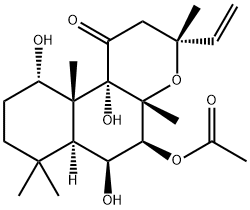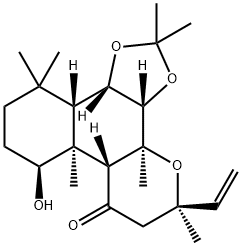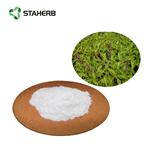Description
Forskolin (66575-29-9) is a widely used adenylate cyclase activator.1 Forskolin also is a positive inotropic agent, vasodilator and induces platelet activation among other activities.2-5
Chemical Properties
Colorless Crystalline Solid
Uses
Cyclic AMP (cAMP) is an important signal carrier necessary for the proper biological response of cells to hormones, neurotransmitters, and other extracellular signals Forskolin is a naturally occurring diterpene that is produced by the Indian Coleus plant (C. forskohlii). It directly activates adenylyl cyclase through its catalytic subunit and is commonly used to raise levels of cAMP in a wide variety of intact cells and tissue preparations. Forskolin binds to adenylyl cyclase in membranes from stably transfected Sf9 cells expressing type 1 adenylyl cyclase with an IC50 value of 41 nM and demonstrates an EC50 value of 0.5 μM in an activation assay assessing formation of cAMP from ATP. Forskolin also interacts with glucose transporters and certain ion channels and has been used for examining adenylyl cyclase expression, regulation, and G protein signaling.[Cayman Chemical]
Uses
In purification of adenylate cyclase.
Uses
Forskolin is a diterpene isolated from Coleus forskohlii, possessing vasodilating and cardiostimulatory properties. Forskolin resensitizes cell receptors by activating the enzyme adenylyl cyclase and increasing the intracellular levels of cAMP.
Uses
adenylate cyclase activator, antiglaucoma, hypotensive, vasodilator
Uses
An adenylate cyclase activator and MAP kinase inhibitor
Uses
glucocorticoid, antiinflammatory
Definition
ChEBI: Forskolin is a labdane diterpenoid isolated from the Indian Coleus plant. It has a role as a plant metabolite, an anti-HIV agent, a protein kinase A agonist, an adenylate cyclase agonist, an antihypertensive agent and a platelet aggregation inhibitor. It is a labdane diterpenoid, an acetate ester, an organic heterotricyclic compound, a triol, a cyclic ketone and a tertiary alpha-hydroxy ketone.
General Description
Forskolin, present predominantly in the root of
Coleus forskohlii plant, is a potential pharmacological compound. It is used for treating hypertension, respiratory disorders and obesity. Forskolin is a diterpenoid capable of modulating adenylate cyclase enzyme and cyclic adenosine monophosphate (cAMP) levels. Engineering forskolin biosynthetic pathway caters its commercial production for pharmacological use. Forskolin has antioxidant and anti-inflammatory property and reduces hyperglycemia by stimulating insulin release. Forskolin promotes differentiation of hepatoma HepaRG cells and activates farnesoid X receptor (FXR) and pregnane X receptor(PXR).
Biological Activity
Cell-permeable activator of adenylyl cyclase. Hypotensive and vasodilatory agent. Induces neuronal differentiation in stem cells and in several neuroblastoma. Also available as part of the PKA Tocriset™ .
Biochem/physiol Actions
Cell permeable: yes
storage
-20°C (desiccate)
Purification Methods
It is an antihypertensive, a positive ionotropic, a platelet aggregation inhibitor, and it has adenylate cyclase activating properties [Chem Abstr 89 244150 1978, de Souza et al. Med Res Rev 3 201 1983, X-ray: Tandon et al. Indian J Chem 15B 880 1977]. [Beilstein 18/5 V 55.]
References
1) Awad et al (1983) Interactions of forskolin and adenylate cyclase; J. Biol. Chem., 258 2960
2) Bhat et al (1983) The antihypertensive and positive inotropic diterpene forskolin: effects of structural modifications on its activity; J. Med. Chem., 26 486
3) de Souza et al. (1983) Forskolin: a labdane diterpenoid with antihypertensive, positive inotropic, platelet aggregation inhibitory, and adenylate cyclase activating properties; Med. Res. Rev. 3 201
4) Aylwin & White (1992) Forskolin acts as a noncompetitive inhibitor of nicotinic acetylcholine receptors; Mol. Pharmacol. 41 908
5) Insel & Ostrom (2003) Forskolin as a tool for examining adenylyl cyclase expression, regulation, and G protein signaling; Cell Mol. Neurobiol., 23 305





